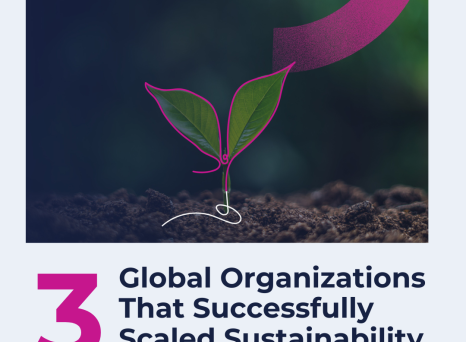The increasing emphasis on sustainability affects all aspects of business operations. Functions like manufacturing and transportation play a clear part in any sustainability commitment.
The increasing emphasis on sustainability affects all aspects of business operations. Functions like manufacturing and transportation play a clear part in any sustainability commitment. But for other departments, like IT, your role might not be as immediately obvious.
January 2023 saw the introduction of the Corporate Sustainability Reporting Directive (CSRD). This law requires EU companies to create more detailed reports on their ESG impact, using the European Sustainability Reporting Standards (ESRS) as their guide. And, in 2025, new ESG rating standards that require the European Securities and Markets Authority (ESMA) to authorize ESG rating companies will come into play.
So, as an IT leader, what do you need to know about these regulations? Certainly, your role is critical to your organization’s sustainability commitments. Factors like e-waste, server emissions, data privacy, and cobalt mining all have an impact on your business’s environmental, social, and governance (ESG) performance. And it’s down to IT leaders to manage this.
So, how can you help build a more sustainable and compliant future for your business and the industry as a whole? The answer lies in data accuracy, intelligent technology, and collaboration. Let’s explore.
Corporate Sustainability Reporting Directive (CSRD)
CSRD aims to standardize and expand how businesses report on corporate sustainability. It replaces the Non-Financial Reporting Directive, which required public interest companies with over 500 employees to disclose ESG information. CSRD expands on this and requires more companies to disclose more information. So, who does it apply to?
- Public Interest Entities (PIEs) in EU-regulated markets with:
- More than 500 employees
- A net turnover of over €40 million
- Businesses with assets worth more than €20 million
- Large-scale organizations that meet two or more of the below:
- Over 250 employees
- A net turnover of over €40 million
- Assets worth more than €20 million
- Small and medium enterprises (SMEs) publicly listed in EU-regulated markets
- Non-EU companies with an annual turnover of over €150 million in the EU (with a minimum of one branch in an EU member country)
Different businesses will have different requirements, deadlines, and timeframes to comply with CSRD. It is important to make sure you and your team are prepared.
European Sustainability Reporting Standards (ESRS)
The European Sustainability Reporting Standards (ESRS) are the guidelines businesses must use to report on their ESG to comply with CSRD. The standards outline what ESG data companies need to share and set a consistent framework for reporting. As ESG grows in importance, businesses can also expect more sector-specific changes in the foreseeable future. Industries like oil, gas, and transport, for example, may be required to share even greater details of their ESG commitment. IT leaders are often the gatekeepers of this valuable data. In turn, they will become integral to helping businesses meet ESRS guidelines by ensuring data accuracy, overseeing data collection, and monitoring compliance.
ESG rating standards
New regulations for ESG raters are due to come into force in January 2025. These will help ensure that the companies performing ESG assessments are doing their due diligence, as well as increasing the visibility of businesses’ ESG data to identify any greenwashing. The key points IT leaders need to be aware of are as follows:
- Companies that assess ESG will have to evaluate E, S, and G separately and provide a rating for each. In turn, reports will deliver more transparent results.
- EU ESG raters must be supervised by the European Securities and Markets Authority (ESMA).
- Non-EU raters operating in the EU require backing from an EU-authorized provider.
- There will be a drive for double materiality — the practice of assessing your business’s impact on the environment, society, and governance while simultaneously considering how broader changes to ESG influence your business. This offers two important perspectives and helps support long-term success.
- ESG raters must disclose any conflicting business activities they conduct with the organizations they assess. This includes any existing affiliations the rater has with the business it is evaluating, such as consulting, ownership, or investments.
How the Evolution of Standards Impacts IT Leaders
Data collection is crucial to ensuring compliance with new standards and helping you facilitate the creation of accurate ESG reports. IT leaders must identify simple and effective ways to obtain this data while completing ongoing projects and continuing to report on other important business metrics. Here’s what you need to know.
- Identify and implement a tool that centralizes ESG data across the entire organization (and all providers throughout its supply chains). You may need to extract and report on individual team’s data in some cases.
- Ensure the business has the technology in place to create and deliver digital reports in line with European Single Electronic Format (ESEF) requirements.
- Facilitate collaboration between all departments to ensure data accuracy, transparency, consistency, and strategic alignment.
- Monitor regulatory changes and update processes and practices to ensure compliance and a culture of continuous improvement. Tech scalability and customization are pivotal to this.
- Take a closer look at your data. ESG raters will be seeking out more accurate, transparent data than ever before. Consider your data hygiene and the security of your ESG data.
Additionally, there are several ways IT can play a part in improving a business’s overall ESG ratings. Consider the following simple steps:
- Build a business case for energy-efficient data centers.
- Properly dispose of e-waste and always consider refurbishment before replacement.
- Lead the way in digital transformation by eliminating paper use.
- Advocate for remote working and identify the tools and technology required to continue to collaborate effectively.
- Commit to working with vendors, suppliers, and providers whose ESG goals align with yours.
ESG is a Marathon, Not a Race
As the global commitment to ESG grows, so does the burden for IT leaders. Not just to adhere to sustainable practices, but to enable reporting that accurately reflects your ESG efforts and the external ESG influence on your business. This is an opportunity to create positive change, boost efficiencies, and shine an important light on IT’s role in ESG. The right technology is a pivotal step to supporting you on your journey. That’s where the right Project Portfolio Management tool (PPM) comes in.
- Store and centralize all data in one location to deliver a single source of truth.
- Automate reports that show ESG risks, financial insights, consumer demand, and more across the entire business.
- Easily integrate with other technologies, systems, and providers for seamless collaboration and data consistency.
- Gain better visibility, benefit from portfolio prioritization, and align operations with the business’s wider strategy.
PPM tools, like Planisware, are an intelligent solution for businesses. With a single shared view across your organization, Planisware helps IT transform vision into reality.


